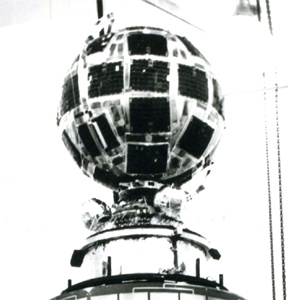 Explorer (56) (DADE-A) satellite | |
| Names | DADE-A Dual Air Density Explorer-A DADE-B Dual Air Density Explorer-B |
|---|---|
| Mission type | Earth science |
| Operator | NASA |
| COSPAR ID | 1975-DADE-A |
| Mission duration | Failed to orbit |
| Spacecraft properties | |
| Spacecraft | Explorer LVI |
| Spacecraft type | Dual Air Density Explorer |
| Bus | DADE |
| Manufacturer | Langley Research Center |
| Launch mass | 40 kg (88 lb) |
| Power | Solar cells and batteries |
| Start of mission | |
| Launch date | 6 December 1975, 03:35:01 UTC[1] |
| Rocket | Scout F-1 (S-196C) |
| Launch site | Vandenberg, SLC-5 |
| Contractor | Vought |
| End of mission | |
| Deactivated | Failed to orbit |
| Orbital parameters | |
| Reference system | Geocentric orbit (planned) |
| Regime | Polar orbit |
| Perigee altitude | 350 km (220 mi) |
| Apogee altitude | 350 km (220 mi) |
| Inclination | 90.10° |
| Period | 90.00 minutes |
| Instruments | |
| Atmospheric Composition Mass Spectrometer Atmospheric Drag Density | |
Dual Air Density Explorer was a set of 2 satellites, DADE-A and DADE-B, released as part of NASA's Explorer program. DADE-A and DADE-B was launched on 6 December 1975 at 03:35:01 UTC,[1] by a Scout F-1 launch vehicle from Space Launch Complex 5, Vandenberg Air Force Base, California. The launch of the DADE satellites failed.[2][3]
- ^ a b "Launch Log". Jonathan's Space Report. 21 July 2021. Retrieved 19 November 2021.
- ^ "Display: DADE-A". NASA. 28 October 2021. Retrieved 19 November 2021.
 This article incorporates text from this source, which is in the public domain.
This article incorporates text from this source, which is in the public domain.
- ^ "Display: DADE-B". NASA. 28 October 2021. Retrieved 19 November 2021.
 This article incorporates text from this source, which is in the public domain.
This article incorporates text from this source, which is in the public domain.